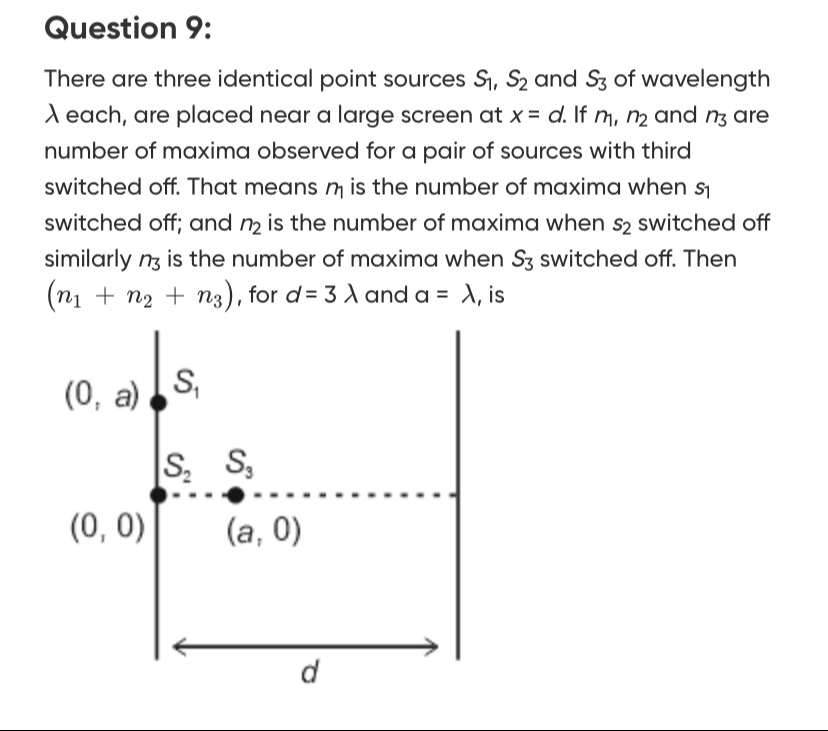Question
Question: There are three identical point sources $S_1$, $S_2$ and $S_3$ of wavelength $\lambda$ each, are pla...
There are three identical point sources S1, S2 and S3 of wavelength λ each, are placed near a large screen at x=d. If n1, n2 and n3 are number of maxima observed for a pair of sources with third switched off. That means n1 is the number of maxima when s1 switched off; and n2 is the number of maxima when s2 switched off similarly n3 is the number of maxima when S3 switched off. Then (n1+n2+n3), for d=3λ and a=λ, is

7
5
6
8
7
Solution
The problem involves calculating the number of maxima observed from pairs of point sources due to interference. The number of maxima for a pair of sources is determined by the range of possible path differences and the condition for constructive interference (Δr=mλ).
1. Pair of sources S1 and S2 (n1) Sources are S1=(0,a) and S2=(0,0). The screen is at x=d. The path difference Δr12 can be approximated for a large screen (d≫a) as Δr12≈2da2−2ay. For maxima, Δr12=mλ. So, 2da2−2ay=mλ. The range of path difference is determined by the limits as y→±∞. As y→±∞, Δr12 ranges from −a to a. So, −a≤mλ≤a, which implies −λa≤m≤λa. Given a=λ, we have −1≤m≤1. The possible integer values for m are −1,0,1. Therefore, n1=3.
2. Pair of sources S1 and S3 (n2) Sources are S1=(0,a) and S3=(a,0). The screen is at x=d. The distance between S1 and S3 is s=(a−0)2+(0−a)2=a2. The maximum possible path difference between these two sources is equal to the distance between them, which is a2. So, the range of path difference is from −a2 to a2. For maxima, Δr13=mλ. Thus, −a2≤mλ≤a2, which implies −λa2≤m≤λa2. Given a=λ, we have −2≤m≤2. The possible integer values for m are −1,0,1. Therefore, n2=3.
3. Pair of sources S2 and S3 (n3) Sources are S2=(0,0) and S3=(a,0). The screen is at x=d. The path difference Δr23 can be approximated for a large screen as Δr23≈a−2d(d−a)ay2. The maximum path difference occurs at y=0, where Δr23(0)=d−(d−a)=a. As ∣y∣→∞, Δr23→0. So, the range of path difference is (0,a]. For maxima, Δr23=mλ. Thus, 0<mλ≤a, which implies 0<m≤λa. Given a=λ, we have 0<m≤1. The only possible integer value for m is 1. Therefore, n3=1.
The total number of maxima is (n1+n2+n3)=3+3+1=7.
